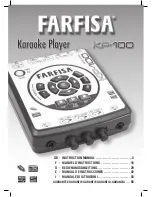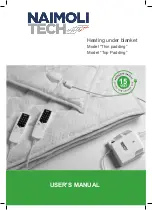
Hot-Shot™
5.
Use safety equipment. Always wear eye
protection.
Dust mask, non-skid safety shoes, hard
hat, or hearing protection must be used for
appropriate conditions.
Tool Use and Care
1.
Use clamp or other practical way to secure and
support the workpiece to a stable platform.
Holding the work by hand or against your body is
unstable and may lead to loss of control.
2.
Do not use tool if switch does not turn it on or
off.
Any tool that cannot be controlled with the
switch is dangerous and must be repaired.
3.
Disconnect the plug from the power source
before making any adjustments, changing
accessories, or storing the tool.
Such
preventative safety measures reduce the risk of
starting the tool accidentally.
4.
Store idle tools out of reach of children and
other untrained persons.
Tools are dangerous in
the hands of untrained users.
5.
Use only accessories that are recommended by
the manufacturer for your model.
Accessories
that may be suitable for one tool may become
hazardous when used on another tool.
Tool Service
1.
Tool service must be performed only by qualified
repair personnel.
Service or maintenance
performed by unqualified repair personnel could
result in injury.
2.
When servicing a tool, use only identical
replacement parts. Follow instructions in the
Maintenance section of this manual.
Use of
unauthorized parts or failure to follow Maintenance
Instructions may create a risk of electric shock or
injury.
Introduction
A frozen water pipe can be thawed very quickly by
passing low voltage high current electricity through the
frozen pipe.
Plastic pipe will not conduct electricity
so this method will not work on plastic pipe.
There
must be unfrozen water under standard water pressure
on one side of the frozen part of the pipe and an open
faucet on the other side.
When thawing a frozen section of water pipe, heat the
pipe only enough to melt a thin film of ice in the inside of
the pipe.
A faucet must be opened
in the unfrozen
part of the line down stream from the frozen section.
The warmer water above the ice will seep through the
melted film and very quickly melt the rest of the ice. The
water will start to flow in about 10 minutes if the
connections are properly made. Since copper pipe will
not heat as fast as steel pipe, allow about a 30 percent
longer thawing time. (See Chart)
Features
•
The Hot-Shot 320 puts out 320 amps, yet pulls only
14 amps. It can clear 1/2" to 1-1/2" pipes up to 100
ft. long. The Hot-Shot 400 can clear 1/2" to 1-1/2"
pipes up to 175 ft. long.
•
The Hot Shot 400 features a "High/Low" switch to
allow the unit to be used on either a 15 amp or a 20
amp outlet. When the "High/Low" switch is in the
"Low" position, the unit will draw 14 amps and
supply 320 amps of thawing power. When in the
"High" position, it will draw up to 20 amps and
supply 400 amps of thawing power.
•
Both units have a built-in thermal protector. If the
internal temperature reaches a critical level, the Hot-
Shot will automatically shut down.
Warnings
•
The Hot-Shot 320 requires a 115 volt AC grounded
15 amp circuit.
•
Be sure the unit is plugged into a
properly
grounded
receptacle. If in doubt, check receptacle
before plugging in unit.
•
If the power cord supplied with the unit is not long
enough, be sure to use a grounded heavy duty
extension cord that is in good condition. Using
lighter cords can result in severe power loss and
overheating.
•
There is a possibility that the output current of the
unit may be transferred into the electrical service,
either at the house being thawed, or at a remote
location. Therefore, all grounds (i.e. electric service,
telephone, and cable TV grounds) must be
disconnected, both at the house being thawed and
all houses on the same distribution transformer.
•
Do not leave unit unattended while thawing. Do not
leave unit operating overnight.
Operating Instructions
1. Isolate the frozen section of pipe. Inside a house,
this is done by opening faucets and back tracking
the pipes. The frozen section will usually be in the
outside walls, near doors, windows and in crawl
spaces under floors. If all the water outlets in the
house fail to operate, the line from the curb valve to
the house is frozen.
2. House service pipes usually have to be thawed by
connecting one cable to the exposed pipe in the
kitchen or basement and other cable to the curb
service. At the curb, make the connection to the
valve at the bottom of the service riser, using the
curb key. Do not connect the cable to the adjustable
ground level cover as it is a poor connection to the
valve.
3






















